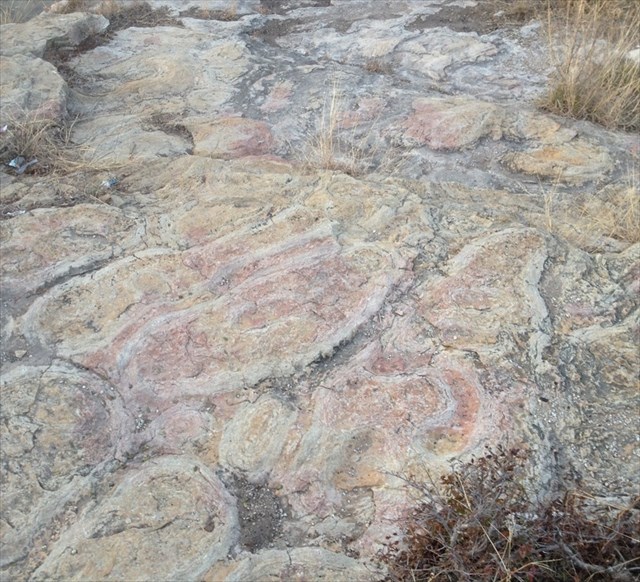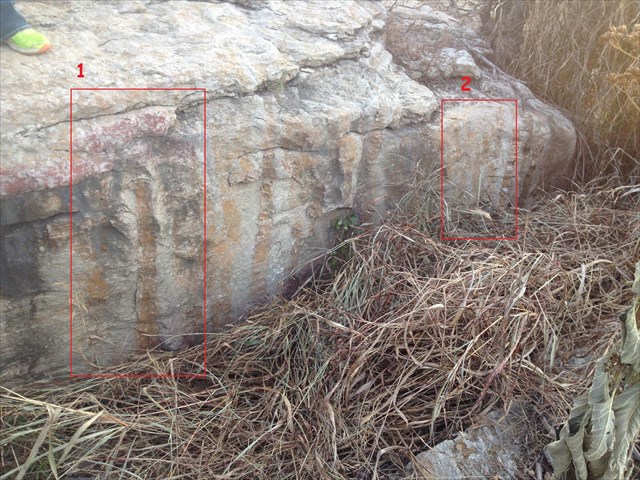Stromatolites are layered structures typically created by microbial mats, which trap passing sediments. They are generally produced in shallow seas with a strong tidal action. As the tide comes in water brings new dirt and other floating particles. When the tide leaves the microbial mats trap the floating particles. Over time, subsequent microbial growth traps additional layers of dirt which cause the stromatolite to grow larger (kind of like stacking pancakes on top of each other). These microbial fossils are one of Earth's earliest records of life. The earliest known stromatolite fossils are between 2.75 - 3.5 billion years old in the Precambrian period.

Earth's current atmosphere was created by the blue-green algae in these important early stromatolite colonies. At this site you will be looking at hundreds of examples of elongated stromatolites, (in the form of concretions), which are the fossilized remains of the microbial mats which formed in limestone- or dolostone-forming environments. You will be measuring some of these elongated fossils, so please bring a tape measure (a 180 cm (6 foot) tape works well and is more than enough). Stromatolite localities are rather rare worldwide, and this site is of exceptional quality due to the size and number of well-preserved specimens. Because of the scientific importance of this site, please refrain from any collecting, including other geological material. The stromatolites at this site are weathering out of a silicified limestone layer within the San Saba Member of the Wilberns Formation, and are about 541-485 million years old.

At this Earthcache location with your back to the river (looking south) you will see where the section of rock you’re standing on has broke away from the rock in front of you, leaving a cross section of the stromatolites to view. You will need your tape measure for this part. You will need to measure the far left and far right portions of the ledge in front of you (see picture below). The grass might be growing and you may have to pull it away from the rock face on the right side to get accurate measurements.

According to research conducted on stromatolites which are actively growing in Australia, the growth rate of a stromatolite is approximately 0.5 mm/year. Assuming that this growth rate is constant, and that this is the rate at which this stromatolite grew, answer the questions below.
To log this EarthCache, send me an email with the answers to these questions:(updated 5/21/2020)
1) Measure the height of the layer of silicified limestone at this location for 1 and 2 in picture above, what are they in milimeters? (two answers)
2) How long did it take the stromatolite at these coordinates to grow to this height? (two answers)
3) How much geological time is missing between 2 and 1?
4) What do these stromatolites tell you about what this area was like millions of years ago?
5) Post a picture of yourself or a personal item at the river with the bridge in the background that shows you visited the site. REQUIRED
NOTE: If you post ANY answers to the questions above in your log it will be deleted. If you fail to send an e-mail within 7 days of your found log, your log will be deleted. I encourage pictures (it makes it fun!) but nothing that will help arm chair cachers answer any of the questions. If you are caching as a group, the person sending the answers MUST reference each individual in the group, no need to send 12 e-mails when one e-mail with 12 usernames will be sufficient. No "I'm with him" logs.
“Living” stromatolite communities are currently very rare, and exist in only a few localities worldwide. Modern-day stromatolites were discovered in Shark Bay, Australia in 1956 pictured below.
